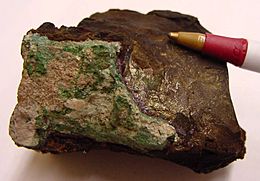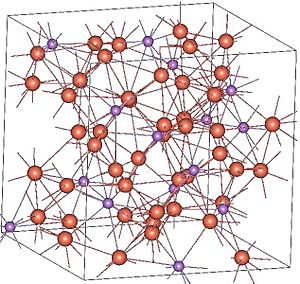Domeykite facts for kids
Quick facts for kids Domeykite |
|
|---|---|
 |
|
| General | |
| Category | Arsenide mineral |
| Formula (repeating unit) |
Cu3As |
| Strunz classification | 2.AA.10b |
| Crystal symmetry | I43d |
| Unit cell | a = 9.62 Å; Z = 16 |
| Identification | |
| Formula mass | 265.56 g/mol |
| Color | Tin-white to steel-gray |
| Crystal habit | Reniform, botryoidal; massive |
| Crystal system | Isometric |
| Cleavage | None |
| Tenacity | Brittle - sectile |
| Mohs scale hardness | 3-3.5 |
| Luster | Metallic |
| Streak | Black gray |
| Diaphaneity | Opaque |
| Specific gravity | 7.2 - 8.1, average = 7.65 |
| Other characteristics | Tarnishes pale yellow, then pale brown, and finally to iridescence |
Domeykite is a special kind of mineral that's made mostly of copper and arsenic. Imagine it like a natural rock that has these two elements mixed together! It's usually found as bumpy, irregular lumps rather than shiny, perfect crystals.
This mineral is quite heavy and has a cool metallic look, like tin or steel. It's also pretty hard, but you could scratch it with a knife. When you find it, it might look white or gray. Over time, it can change color to a brassy yellow or even show a rainbow shimmer!
Domeykite was first discovered way back in 1845. It was found in some mines called Algodones in a place called Coquimbo, in Chile. A scientist named Wilhelm Haidinger gave it its name. He named it after a famous Polish mineralogist (that's a scientist who studies minerals) named Ignacy Domeyko.
Uses of Domeykite
Even though Domeykite isn't super common, it's still useful!
- Getting Copper: Domeykite is a minor ore of copper. This means it's one of the rocks from which we can get copper metal. Copper is used for many things, like wires and pipes.
- For Decoration: Sometimes, Domeykite can be polished. When it's polished, it can be used for pretty decorations or jewelry.

See also
 In Spanish: Domeikita para niños
In Spanish: Domeikita para niños
- List of minerals
- List of minerals named after people


